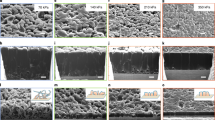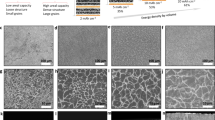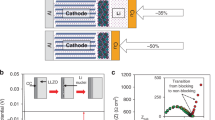Abstract
Lithium metal has been considered an ideal anode for high-energy rechargeable Li batteries, although its nucleation and growth process remains mysterious, especially at the nanoscale. Here, cryogenic transmission electron microscopy was used to reveal the evolving nanostructure of Li metal deposits at various transient states in the nucleation and growth process, in which a disorder–order phase transition was observed as a function of current density and deposition time. The atomic interaction over wide spatial and temporal scales was depicted by reactive molecular dynamics simulations to assist in understanding the kinetics. Compared to crystalline Li, glassy Li outperforms in electrochemical reversibility, and it has a desired structure for high-energy rechargeable Li batteries. Our findings correlate the crystallinity of the nuclei with the subsequent growth of the nanostructure and morphology, and provide strategies to control and shape the mesostructure of Li metal to achieve high performance in rechargeable Li batteries.
This is a preview of subscription content, access via your institution
Access options
Access Nature and 54 other Nature Portfolio journals
Get Nature+, our best-value online-access subscription
$29.99 / 30 days
cancel any time
Subscribe to this journal
Receive 12 print issues and online access
$259.00 per year
only $21.58 per issue
Buy this article
- Purchase on Springer Link
- Instant access to full article PDF
Prices may be subject to local taxes which are calculated during checkout






Similar content being viewed by others
Data availability
The data that support the findings of this study are available from the corresponding authors upon reasonable request. Source data are provided with this paper.
References
Steiger, J., Kramer, D. & Mönig, R. Mechanisms of dendritic growth investigated by in situ light microscopy during electrodeposition and dissolution of lithium. J. Power Sources 261, 112–119 (2014).
Wood, K. N. et al. Dendrites and pits: untangling the complex behavior of lithium metal anodes through operando video microscopy. ACS Cent. Sci. 2, 790–801 (2016).
Cohen, Y. S., Cohen, Y. & Aurbach, D. Micromorphological studies of lithium electrodes in alkyl carbonate solutions using in situ atomic force microscopy. J. Phys. Chem. B 104, 12282–12291 (2000).
Mogi, R., Inaba, M., Iriyama, Y., Abe, T. & Ogumi, Z. In situ atomic force microscopy study on lithium deposition on nickel substrates at elevated temperatures. J. Electrochem. Soc. 149, A385–A390 (2002).
Orsini, F. et al. In situ scanning electron microscopy (SEM) observation of interfaces within plastic lithium batteries. J. Power Sources 76, 19–29 (1998).
Cheng, J.-H. et al. Visualization of lithium plating and stripping via in operando transmission X-ray microscopy. J. Phys. Chem. C 121, 7761–7766 (2017).
Kushima, A. et al. Liquid cell transmission electron microscopy observation of lithium metal growth and dissolution: root growth, dead lithium and lithium flotsams. Nano Energy 32, 271–279 (2017).
Li, Y. et al. Atomic structure of sensitive battery materials and interfaces revealed by cryo–electron microscopy. Science 358, 506–510 (2017).
Wang, X. et al. New insights on the structure of electrochemically deposited lithium metal and its solid electrolyte interphases via cryogenic TEM. Nano Lett. 17, 7606–7612 (2017).
Dubrovskii, V. in Nucleation Theory and Growth of Nanostructures 1–73 (Springer, 2014).
Scharifker, B. R. & Mostany, J. in Encyclopedia of Electrochemistry 512–539 (Wiley, 2007).
Ely, D. R., Jana, A. & García, R. E. Phase field kinetics of lithium electrodeposits. J. Power Sources 272, 581–594 (2014).
Ely, D. R. & García, R. E. Heterogeneous nucleation and growth of lithium electrodeposits on negative electrodes. J. Electrochem. Soc. 160, A662–A668 (2013).
Akolkar, R. Modeling dendrite growth during lithium electrodeposition at sub-ambient temperature. J. Power Sources 246, 84–89 (2014).
Akolkar, R. Mathematical model of the dendritic growth during lithium electrodeposition. J. Power Sources 232, 23–28 (2013).
Chazalviel, J. N. Electrochemical aspects of the generation of ramified metallic electrodeposits. Phys. Rev. A 42, 7355–7367 (1990).
Wang, X., Li, Y. & Meng, Y. S. Cryogenic electron microscopy for characterizing and diagnosing batteries. Joule 2, 2225–2234 (2018).
Wang, F. et al. Chemical distribution and bonding of lithium in intercalated graphite: identification with optimized electron energy loss spectroscopy. ACS Nano 5, 1190–1197 (2011).
Loh, N. D. et al. Multistep nucleation of nanocrystals in aqueous solution. Nat. Chem. 9, 77–82 (2017).
Yang, J. et al. Amorphous-phase-mediated crystallization of Ni nanocrystals revealed by high-resolution liquid-phase electron microscopy. J. Am. Chem. Soc. 141, 763–768 (2019).
Liao, H.-G., Cui, L., Whitelam, S. & Zheng, H. Real-time imaging of Pt3Fe nanorod growth in solution. Science 336, 1011–1014 (2012).
Wittig, J. E., Bentley, J. & Allard, L. F. In situ investigation of ordering phase transformations in FePt magnetic nanoparticles. Ultramicroscopy 176, 218–232 (2017).
Chi, M. et al. Surface faceting and elemental diffusion behaviour at atomic scale for alloy nanoparticles during in situ annealing. Nat. Commun. 6, 8925 (2015).
van Duin, A. C. T., Dasgupta, S., Lorant, F. & Goddard, W. A. ReaxFF: a reactive force field for hydrocarbons. J. Phys. Chem. A 105, 9396–9409 (2001).
Plimpton, S., Crozier, P. & Thompson, A. LAMMPS-large-scale atomic/molecular massively parallel simulator. Sandia Natl Laboratories 18, 43 (2007).
Majure, D. L. et al. Large-scale atomic/molecular massively parallel simulator (LAMMPS) simulations of the effects of chirality and diameter on the pullout force in a carbon nanotube bundle. In 2008 DoD HPCMP Users Group Conference 201–207 (IEEE, 2008).
Stukowski, A. Visualization and analysis of atomistic simulation data with OVITO–the open visualization tool. Model. Simul. Mater. Sci. Eng. 18, 015012 (2009).
Onofrio, N. & Strachan, A. Voltage equilibration for reactive atomistic simulations of electrochemical processes. J. Chem. Phys. 143, 054109 (2015).
Jensen, B. D., Wise, K. E. & Odegard, G. M. The effect of time step, thermostat, and strain rate on ReaxFF simulations of mechanical failure in diamond, graphene, and carbon nanotube. J. Comput. Chem. 36, 1587–1596 (2015).
Cui, Z., Gao, F., Cui, Z. & Qu, J. Developing a second nearest-neighbor modified embedded atom method interatomic potential for lithium. Model. Simul. Mater. Sci. Eng. 20, 015014 (2011).
Stukowski, A. Structure identification methods for atomistic simulations of crystalline materials. Model. Simul. Mater. Sci. Eng. 20, 045021 (2012).
Baldan, A. Review progress in Ostwald ripening theories and their applications to nickel-base superalloys part I: Ostwald ripening theories. J. Mater. Sci. 37, 2171–2202 (2002).
Nanev, C. N. in Handbook of Crystal Growth 2nd edn, 315–358 (Elsevier, 2015).
Karthika, S., Radhakrishnan, T. K. & Kalaichelvi, P. A review of classical and nonclassical nucleation theories. Cryst. Growth Des. 16, 6663–6681 (2016).
Greer, A. L. Metallic glasses. Science 267, 1947–1953 (1995).
Jafary-Zadeh, M. et al. A critical review on metallic glasses as structural materials for cardiovascular stent applications. J. Funct. Biomater. 9, 19 (2018).
Chen, M. A brief overview of bulk metallic glasses. NPG Asia Mater. 3, 82–90 (2011).
Khan, M. M. et al. Recent advancements in bulk metallic glasses and their applications: a review. Crit. Rev. Solid State Mater. Sci. 43, 233–268 (2018).
Acknowledgements
We thank the UC Irvine Materials Research Institute (IMRI) for the use of the Cryo-Electron Microscopy Facility and Kratos XPS, funded in part by the National Science Foundation Major Research Instrumentation Program under grant no. CHE-1338173. We thank X. Pan, T. Aoki, L. Xing and J.-G. Zheng for their assistance with the microscopy. Work at the Molecular Foundry was supported by the Office of Science, Office of Basic Energy Sciences, of the US Department of Energy under contract no. DE-AC02-05CH11231. The SEM was performed in part at the San Diego Nanotechnology Infrastructure (SDNI), a member of the National Nanotechnology Coordinated Infrastructure, which is supported by the National Science Foundation (grant ECCS-1542148). We also thank A. van Duin of the Pennsylvania State University for providing the ReaxFF parameters used in this work. We thank W. Xu and M. Olguin for discussing the results. This work is supported by the Assistant Secretary for Energy Efficiency and Renewable Energy, Office of Vehicle Technologies of the US Department of Energy in the Advanced Battery Materials Research (BMR) Program (Battery500 Consortium). Idaho National Laboratory (INL) is operated by Battelle Energy Alliance under contract no. DE-DE-AC07-05ID14517 for the US Department of Energy.
Author information
Authors and Affiliations
Contributions
X.W., Y.S.M. and B.L. conceived the idea. X.W. designed the experiments and conducted the cryo-TEM. Y.L., B.L., M.Z. and A.B. helped with cell making, electrochemical performance evaluation, EELS and SEM. X.W., Y.L. and Y.S.M. analysed and discussed the experimental data. X.W. and Y.L. made the schematic images. G.P., E.D. and B.L. developed the concept of the r-MD approach. G.P. conducted the simulation work. B.L. provided the major interpretation and discussion of the r-MD results in the paper. X.R. and J.Z. provided the advanced electrolyte and the anode-free electrochemical performance. P.L., J.X., J.L. and E.D. participated in discussing the results and commenting on the manuscript. The manuscript was mainly written and revised by X.W., B.L., G.P. and Y.S.M. All authors approved the final version of the manuscript.
Corresponding authors
Ethics declarations
Competing interests
The authors declare no competing interests.
Additional information
Publisher’s note Springer Nature remains neutral with regard to jurisdictional claims in published maps and institutional affiliations.
Co-first authors: Xuefeng Wang, Gorakh Pawar.
Extended data
Extended Data Fig. 1 Influence of local mass transport, energy transfer and current density (as represented by packing density) on the nucleation and phase transition of Li metal deposits by using ensembles of 600 Li atoms as the basis for the simulation.
The packing density in a-d is 0.0534, 0.13, 0.27 and 0.47 g cm−3 respectively. The crystal structure (that is the bcc lattice) is represented in blue, whereas the amorphous fractions or phases in white or grey.
Extended Data Fig. 2
Cryo-TEM images (a-d) and their FFT patterns (e-h) of Li deposits at 0.5 mA cm-2 for 2h. Besides (110) plane of Li metal, lattice fringes or FFT spots with lattice spacing of ~0.174 and ~0.142 nm was also observed, which belongs to the (200) and (211) planes of Li metal, respectively. Specially in d and h, both (200) and (110) planes of Li metal are present, which helps to determine the zone axis of [001] and confirm the phase of Li metal.
Extended Data Fig. 3
Cryogenic STEM image (a), EELS Mapping (b) and spectra (c) of EDLi obtained at 0.5 mA cm-2 for 2h. The EELS mapping (b) is based on the intensity EELS spectra ranging from 53.5 eV to 58.5 eV (highlighted by the blue square in c), which contains the characteristic metallic/elemental Li K-edge threshold at about 55 eV. c presents the EELS spectra taken from Area 1 and Area 2 (labeled in b) representing the feature of highly crystalline Li and glassy Li respectively. Due to the presumed same SEI on the surface of Area 1 and Area 2, they show similar extended fine structure of Li K-edge after 60 eV. Both of them have the obvious characteristic metallic/elemental Li K-edge threshold at about 55 eV while the highly crystalline Li Area 1 shows a peak with slightly higher intensity than the glassy Li Area 2. This is reasonable due to the different degree of order/disorder structure in these two areas. It is worth to noting that it is difficult to obtain the higher-resolution STEM mapping due to the radiation damage caused by the high-energy beam used for STEM scanning even at cryogenic temperature.
Extended Data Fig. 4 Nanostructure evolution of Na, K, Mg and Zn deposits as a function of current density.
TEM images (a-d and i-l) and the corresponding FFT patterns (e-h and m-p) of Na at 0.1 mA cm−2 (a and e) and 0.5 mA cm−2 (i and m), K at 0.1 mA cm−2 (b and f) and 0.5 mA cm−2 (j and n), Mg at 0.05 mA cm−2 (c and g) and 0.1 mA cm−2 (k and o) and Zn at 0.1 mA cm−2 (d and h) and 0.5 mA cm−2 (l and p). The crystalline portion of the Na, K, Mg, and Zn deposits are labeled by the white dash lines.
Supplementary information
Supplementary Information
Supplementary Figs. 1–21, discussion and Tables 1–2.
Supplementary Video 1
The heating stage during the simulated annealing approach. The kinetics of the Li nucleation are intriguing. Several nucleation sites rapidly formed and continued to evolve, showing substantial variability in the nucleation kinetics.
Supplementary Video 2
The quenching stage during the simulated annealing approach. The coarsening and condensation of intermediate Li nucleation sites (nuclei) resulted in crystalline clusters with sizes in the range of 2–5 nm. This crystalline cluster size range is critical in determining the material’s reactivity in practical applications.
Supplementary Video 3
The equilibration stage during the simulated annealing approach. The cluster that evolved through maturation either remained in an amorphous state at lower current densities or transformed into a ‘crystalline’ state at higher current densities.
Supplementary Video 4
The condensation process at a relatively lower current density (for example, an ensemble with 500 Li atoms). The Li aggregate remained amorphous even after 5.3 ns in simulation. Irrespective of the timescale, the nanostructure is the key that could substantially impact the underlying material’s properties and have profound implications in a variety of applications such as in electrodeposition, catalysis, semiconductor fabrication and so on.
Supplementary Video 5
The condensation process at a relatively moderate current density (for example, an ensemble with 700 Li atoms). The condensed Li aggregate remained in an amorphous state with a long incubation time (>2 ns) and eventually transformed into a nucleus structure.
Supplementary Video 6
The condensation process at a relatively higher current density (for example, an ensemble with 900 Li atoms). The initial amorphous Li cluster rapidly transformed into a crystalline structure with a substantially short incubation time (<0.7 ns). Accessing such information at the nanosecond and/or picosecond timescales could be challenging with the experimental methods.
Source data
Source Data Fig. 2
Numerical data.
Source Data Fig. 5
Numerical data.
Source Data Extended Data Fig. 3
Numerical data.
Rights and permissions
About this article
Cite this article
Wang, X., Pawar, G., Li, Y. et al. Glassy Li metal anode for high-performance rechargeable Li batteries. Nat. Mater. 19, 1339–1345 (2020). https://doi.org/10.1038/s41563-020-0729-1
Received:
Accepted:
Published:
Issue Date:
DOI: https://doi.org/10.1038/s41563-020-0729-1
This article is cited by
-
External-pressure–electrochemistry coupling in solid-state lithium metal batteries
Nature Reviews Materials (2024)
-
Cation replacement method enables high-performance electrolytes for multivalent metal batteries
Nature Energy (2024)
-
Tracking lithiation with transmission electron microscopy
Science China Chemistry (2024)
-
Lithium crystallization at solid interfaces
Nature Communications (2023)
-
Investigating microstructure evolution of lithium metal during plating and stripping via operando X-ray tomographic microscopy
Nature Communications (2023)



